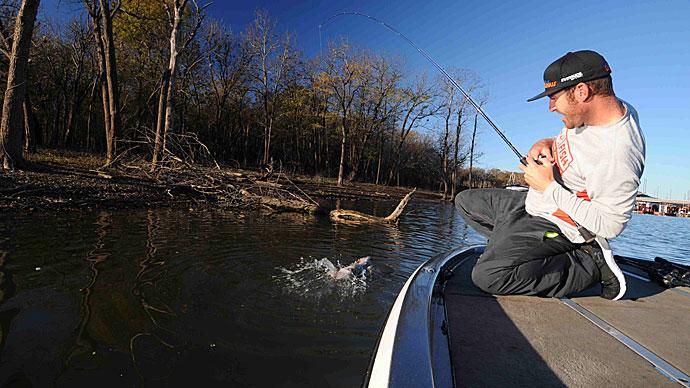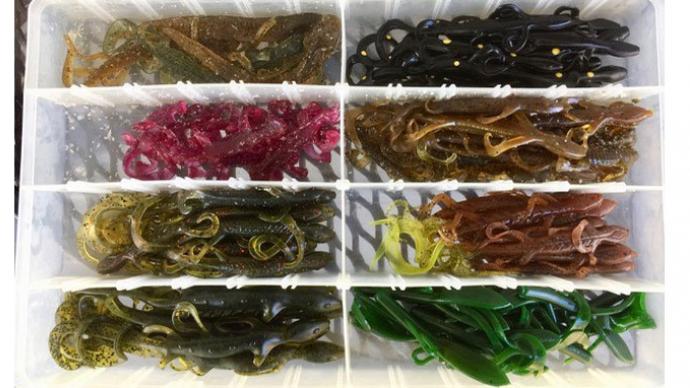| "...bass fishermen leave their homes more prepared than Boy Scouts. They have at least two of everything in five different colors. They all have the equipment necessary to confront anything short of a nuclear attack." |
| --Jimmy Houston |
One of the necessities of bass fishing, tackle boxes come in many different sizes, shapes, and styles, some of which will suit your way of fishing more than others. Here are the main categories:
|
Image

Possum belly Possum belly boxes are usually the largest, heaviest, and most expensive. They are designed to hold everything you're likely to need on the water and are the favorites of many tournament fishermen. |
Image
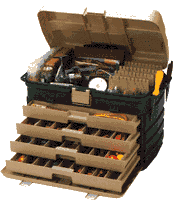
Drawer Drawer boxes offer large storage capacity and do not require as much clearance as a possum belly-style box when opening the drawers. |
|
Image
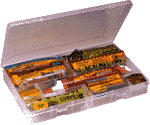
Utility Utility boxes are inexpensive plastic boxes, often clear, designed for a wide variety of storage needs, not just fishing tackle. They are useful for holding small tackle items. |
Image
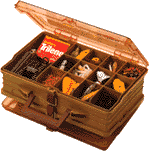
Two-sided Two-sided boxes have compartments on each side and have a surprisingly large capacity for their size. |
|
Image
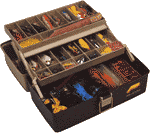
Fold-out Fold-out or hip-roof tackle boxes are the most popular and least expensive. One or two tackle trays and a larger bottom compartment is a common form of this box. |
Image
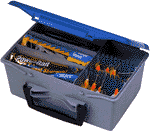
Modular Modular tackleboxes are designed to hold certain lures or tackle items, such as pork rind, lure scents, spinnerbaits, etc. |
|
Image
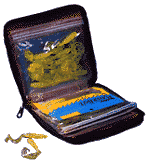
Soft-plastic Soft-plastic tackleboxes can be "molded" to fit tight storage spaces and are very light in weight. |
Image
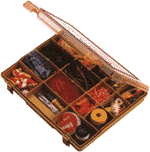
One-sided One-sided tackleboxes are smaller versions of the two-sided models for use when less capacity is needed. |
Organizing Your Tacklebox
Inexperienced fishermen tend to buy a tacklebox that's too small for their growing needs. Experienced fishermen tend to carry too much "stuff" with them. Between these two extremes is an ideal compromise. Here are some tips:
- Store worms and other soft-plastic baits in a "worm-proof" container away from other lures. This will prevent the chemical reaction that can happen when soft plastics and baits of other materials are stored together.
- Rather than buying one giant tackle box to carry everything you own, buy two or three smaller boxes to contain certain categories of lures. Such as worms, spinnerbaits, and plugs.
- Or consider using "seasonal" boxes designed to carry only those lures you'll use in a given season. Each of these boxes can be considerably more compact, and less expensive, than a giant box.
Seasonal Tacklebox Lure Selection
| Spring | spinnerbaits, jigs, plastic worms, minnow lures, etc. |
| Summer | Plastic worms, spinnerbaits, buzzbaits, crankbaits, noisy topwaters, flipping jigs, tail-spinners, etc. |
| Fall | Jigs, grubs, crankbaits, topwaters, thin metal vibrating baits, Rat-L-Trap, etc. |
| Winter | Jigs, grubs, jigging spoons, thin-metal vibrating baits, etc. |
Other Items to Carry
| Nail clippers | compass | snaps & swivels | sunscreen |
| camera | O-Rings | needlenose pliers | first-aid kit |
| insect repellent | knife | fish attractant | extra line |
| hook sharpener | hand towel | scale | worm dye kit |
Tips
- Carry a spice bottle of garlic powder in your boat. After you put on lotion, sprinkle a little in your hand and rub them together. Garlic covers everything... see you on the water.
- When using a drawer or a utility box tackle box, try organizing things in one box. Examples: crankbaits/rattletraps, worms, weights, hooks, spinnerbaits, and jigs. This helps you especially when conditions are changing and you need a quick change.


